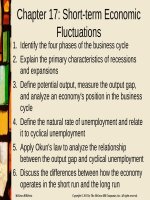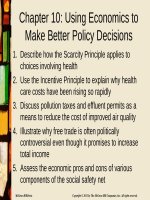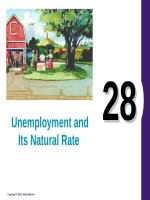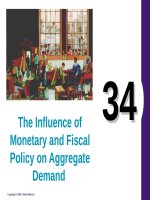Lecture Principles of economics - Chapter 20: Income inequality and poverty
Bạn đang xem bản rút gọn của tài liệu. Xem và tải ngay bản đầy đủ của tài liệu tại đây (553.16 KB, 47 trang )
Income Inequality
and Poverty
Copyright©2004 South-Western
20
Income Inequality and Poverty
A person’s earnings depend on the supply and
demand for that person’s labor, which in turn
depend on natural ability, human capital,
compensating differentials, discrimination, and so
on.
Copyright © 2004 South-Western
THE MEASUREMENT OF
INEQUALITY
• How much inequality is there in our society?
• How many people live in poverty?
• What problems arise in measuring the amount
of inequality?
• How often do people move among income
classes?
Copyright © 2004 South-Western
Table 1 The Distribution of Income
in the United States: 2000
Copyright©2004 South-Western
U.S. Income Inequality
• Imagine that you. . .
• lined up all of the families in the economy
according to their annual income.
• divided the families into five equal groups (bottom
fifth, second fifth, etc.)
• computed the share of total income that each group
of families received.
Copyright © 2004 South-Western
Table 2 Income Inequality in the United States
Copyright©2004 South-Western
U.S. Income Inequality
• If income were equally distributed across all
families, each onefifth of families would
receive onefifth (20 percent) of total income.
Copyright © 2004 South-Western
U.S. Income Inequality
• From 19351970, the distribution of income
gradually became more equal.
• In more recent years, this trend has reversed
itself.
Copyright © 2004 South-Western
U.S. Income Inequality
• Reasons for Recent Increase in Income
Inequality
• The following have tended to reduce the demand
for unskilled labor and raise the demand for skilled
labor:
• Increases in international trade with lowwage countries
• Changes in technology
• Therefore, the wages of unskilled workers have
fallen relative to the wages of skilled workers.
• This has resulted in increased inequality in family
incomes.
Copyright © 2004 South-Western
CASE STUDY: The Women’s Movement and
the Income Distribution
• The percentage of women who hold jobs has
risen from about 32 percent in the 1950s to
about 54 percent in the 1990s.
Copyright © 2004 South-Western
CASE STUDY: Income Equality around the
World
Copyright © 2004 South-Western
The Poverty Rate
• The poverty rate is the percentage of the
population whose family income falls below an
absolute level called the poverty line.
Copyright © 2004 South-Western
Problems in Measuring Inequality
• The Poverty Line
• The poverty line is an absolute level of income set
by the federal government for each family size
below which a family is deemed to be in poverty.
Copyright © 2004 South-Western
Figure 1 The Poverty Rate
Percent of the
Population
below Poverty
Line
25
20
Poverty rate
15
10
5
1960
1965
1970
1975
1980
1985
1990
1995
2000
Copyright©2003 Southwestern/Thomson Learning
Problems in Measuring Inequality
• The Poverty Line and Income Inequality
• As economic growth pushes the entire income
distribution upward, more families are pushed
above the poverty line because the poverty line is an
absolute rather than a relative standard.
• Despite continued economic growth in average
income, the poverty rate has not declined.
• Although economic growth has raised the income of
the typical family, the increase in inequality has
prevented the poorest families from sharing in this
greater economic prosperity.
Copyright © 2004 South-Western
Table 4 Who Is Poor?
Copyright©2004 South-Western
Problems in Measuring Inequality
• Three Facts About Poverty
• Poverty is correlated with race.
• Poverty is correlated with age.
• Poverty is correlated with family composition.
Copyright © 2004 South-Western
Problems in Measuring Inequality
• Data on income distribution and the poverty
rate give an incomplete picture of inequality in
living standards because of the following:
• Inkind transfers
• Life cycle
• Transitory versus permanent income
Copyright © 2004 South-Western
Problems in Measuring Inequality
• InKind Transfers
• Transfers to the poor given in the form of goods and
services rather than cash are called inkind
transfers.
• Measurements of the distribution of income and the
poverty rate are based on families’ money income.
• The failure to include inkind transfers as part of
income greatly affects the measured poverty rate.
Copyright © 2004 South-Western
Problems in Measuring Inequality
• The Economic Life Cycle
• The regular pattern of income variation over a
person’s life is called the life cycle.
• A young worker has a low income at the beginning of his
or her career.
• Income rises as the worker gains maturity and
experience.
• Income peaks at about age 50.
• Income falls sharply at retirement, around age 65.
Copyright © 2004 South-Western
Problems in Measuring Inequality
• Transitory versus Permanent Income
• Incomes vary because of random and transitory
forces.
• Acts of nature
• Temporary layoffs due to illness or economic conditions,
etc.
• A family’s ability to buy goods and services depends
largely on its permanent income, which is its normal, or
average, income.
• Permanent income excludes transitory changes in
income.
Copyright © 2004 South-Western
Economic Mobility
• The movement of people among income classes
is called economic mobility.
• Economic mobility is substantial in the U.S.
economy.
Copyright © 2004 South-Western
Economic Mobility
• Movements up and down the income ladder can
be due to:
• Good or bad luck.
• Hard work or laziness.
• Persistence of economic success from generation to
generation.
Copyright © 2004 South-Western
POLITICAL PHILOSOPHY OF
REDISTRIBUTING INCOME
• What should the government do about
economic inequality?
• Economic analysis alone cannot give us the answer.
• The question is a normative one facing
policymakers.
Copyright © 2004 South-Western
POLITICAL PHILOSOPHY OF
REDISTRIBUTING INCOME
• Three Political Philosophies
• Utilitarianism
• Liberalism
• Libertarianism
Copyright © 2004 South-Western









